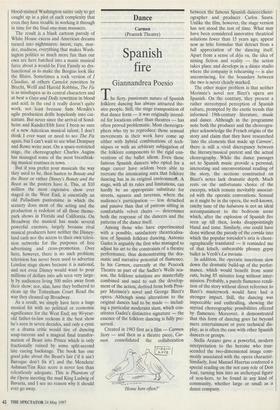Dance
Carmen (Peacock Theatre)
Spanish fire
thannandrea Poesio
The fiery, passionate nature of Spanish folklore dancing has always attracted the- atre people. Still, the stage transposition of that dance form — it was originally intend- ed for locations other than theatres — has often proved problematic. Most choreogra- phers who try to reproduce those sensual movements in their work have come up either with hybrid combinations of tech- niques or with an arbitrary subjugation of the folklore components to the rigid con- ventions of the ballet idiom. Even those famous Spanish dancers who opted for a stage career have seldom been able to recreate the intoxicating aura that folklore dancing has in its original environmerft. A stage, with all its rules and limitations, can hardly be an appropriate substitute for streets, squares and tavernas, where the audience's participation — less detached and passive than that of patrons sitting in comfortable velvet chairs — determines both the response of the dancers and the patterns of the dance itself.
Among those who have experimented with a possible, satisfactory theatricalisa- tion of Spanish folklore dancing, Antonio Gades is arguably the first who managed to adjust his art to the constraints of a theatre performance, thus demonstrating the dra- matic and narrative potential of flamenco. In his Carmen, currently at the Peacock Theatre as part of the Sadler's Wells sea- son, the folklore solutions are masterfully combined and used to suit the develop- ment of the action, derived from both Pros- per Merimee's novel and George Bizet's opera. Although some alterations to the original dances had to be made — includ- ing a particular modernist slant, which con- stitutes Gades's distinctive signature — the essence of the folklore dancing is fully pre- served.
Created in 1983 first as a film — Carmen Story — and then as a theatre piece, Car- men consolidated the collaboration 'Home here often?' between the famous Spanish dancer/chore- ographer and producer Carlos Saura. Unlike the film, however, the stage version has not stood the test of time. What may have been considered innovative theatrical solutions fewer than 15 years ago, appear now as trite formulae that detract from a full appreciation of the dancing itself. Apart from a sense of deja vu, the idea of mixing fiction and reality — the action takes place and develops in a dance studio where the company is rehearsing — is also unconvincing, for the boundary between the two is never clearly marked.
The other major problem is that neither Merimee's novel nor Bizet's opera are Spanish. On the contrary, they present a rather stereotyped perception of Spanish culture, prompted by the exotic trends that informed 19th-century literature, music and dance. Although in the programme note both the producer and the choreogra- pher acknowledge the French origins of the story and claim that they have researched 'into the elements that made up Carmen', there is still a vivid discrepancy between the literary/musical pretext and the actual choreography. While the dance passages set to Spanish music provide a personal, interesting and unconventional reading of the story, the sections constructed on Bizet's notes lack dramatic depth. Much rests on the unfortunate choice of the excerpts, which remain inevitably associat- ed with the operatic conventions. Sensual as it might be in the opera, the well-known, catchy tune of the habanera is not an ideal accompaniment to the bedroom scene which, after the explosion of Spanish fire seen up till then, looks disappointingly bland and tame. Similarly, one could have done without the parody of the corrida into which the popular toreador's aria is chore- ographically translated — it reminded me of that kitsch, unbearable phoney gypsy ballet in Verdi's La traviata.
In addition, the operatic insertions slow down the dramatic build-up of the perfor- mance, which would benefit from some cuts, being 85 minutes long without inter- mission. Probably, a purely flamenco rendi- tion of the story without direct reference to Bizet's masterwork would have had a stronger impact. Still, the dancing was impeccable and enthralling, showing the myriad choreographic possibilities offered by flamenco. Moreover, it demonstrated that this form of dancing goes far beyond mere entertainment or pure technical dis- play, as is often the case with other Spanish dancers or groups.
Stella Arauzo gave a powerful, modern interpretation to the heroine who tran- scended the two-dimensional image com- monly associated with the opera character. Similarly, Jose Manuel Huertas conferred a special reading on the not easy role of Don Jose, turning him into an archetypal figure of non-hero, to be found in any kind of community, whether large or small as a dance company.


























































 Previous page
Previous page